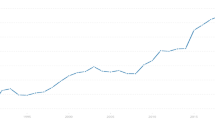Abstract
Here we investigate the relationship between export commodity prices and AUD/USD exchange rate fluctuation using time varying parameter model. Using monthly data for over 30 years we found that exchange rate is determined by commodity prices and Australian base metal indices is highly correlated with country’s exchange rate. We have considered linear Gaussian state space model where common variance is treated as a stochastic time varying variable which gets considered for modeling economic time series.




Similar content being viewed by others
References
Arezki, R., Dumitrescu, E., Freytag, A., & Quintyn, M. (2012). Commodity prices and exchange rate volatility: Lessons from South Africas capital account liberalization. In: Working paper, no. WP/12/168. International Monetary Fund.
Bhar, R. (2015). Commodity export prices and exchange rate: An Australian perspective. International Journal of Economics and Finance, 7(1), 1–13.
Bhar, R., & Bhar, R. (2016). Commodity prices and AUD/USD exchange rate: A regime dependent analysis. Journal of Business and Policy Research, 11(1), 49–61.
Bierens, H. J., & Martins, L. F. (2010). Time-varying cointegration. Econometric Theory, 26(5), 1453–1490.
Brockwell, P. J., & Davis, R. A. (1987). Time series: Theory and methods. New York: Springer.
Chen, Y. C., Rogoff, K., & Rossi, B. (2008) Can exchange rates forecast commodity prices? In: Working paper, no. 13901. National Bureau of Economic Research.
Durbin, J., & Koopman, S. J. (2012). Time series analysis by state space methods. Oxford: Oxford University Press.
Edwards, S. (1985). Commodity export prices and the real exchange rate in develo** countries: coffee in Colombia. In: WP No. 1579. Cambridge, MA: National Bureau of Economic Research.
Engle, R. F., & Watson, M. W. (1987). The Kalman filter: Applications to forecasting and rational expectations models. In T. F. Bewley (Ed.), Advances in econometrics: Fifth world congress (Vol. I). Cambridge: Cambridge University Press.
Hamilton, J. (1994). Time series analysis. Princeton: Princeton University Press.
Harvey, A. C. (1989). Forecasting, structural time series models and the Kalman filter. Cambridge: Cambridge University Press.
Harvey, A. C. (1990). The econometric analysis of time series (2nd ed.). Cambridge, MA: The MIT Press.
Harvey, A. C., & Koopman, S. J. (1997). Trends and cycles in multivariate time series. In C. Heij, H. Schumacher, B. Hanzon, & C. Praagman (Eds.), System dynamics in economic and financial models. Hoboken: Wiley.
Kim, C.-J., Kishor, N. K., & Nelson, C. R. (2006). A time-varying parameter model for a forward-looking monetary policy rule based on real-time data. In: Working paper (UWEC 32 2007). Department of Economics, University of Washington.
Kim, C. J., & Nelson, C. R. (1999). State space models with regime switching. Cambridge, MA: MIT Press.
Kitagawa, G. (2010). Introduction to time series modeling. Boca Raton: Chapman & Hall/CRC.
Kitagawa, G., & Gersch, W. (1985). A smoothness priors time-varying AR coefficient modeling of non-stationary covariance time series. IEEE Transactions on Automatic Control, 30(1), 48–56.
Kitagawa, G., & Gersch, W. (1996). Smoothness priors analysis of time series. New York, NY: Springer.
Mandler, M. (2008). Decomposing federal funds rate forecast uncertainty using real-time data. In: University of Giessen, MPRA Paper No. 18768, posted 20, November 2009/14:25. http://mpra.ub.uni-muenchen.de/18768/.
Prado, R., & Huerta, G. (2002). Time-varying auto regressions with model order uncertainty. Journal of Time Series Analysis, 23(5), 599–618.
Prado, R., & West, M. (1997). Exploratory modelling of multiple non-stationary time series: Latent process structure and decompositions. In T. G. Gregoire, D. R. Brillinger, P. J. Diggle, E. R. Cohen, W. G. Warren, & R. D. Wolfinger (Eds.), Modelling longitudinal and spatially correlated data (pp. 349–361). New York: Springer.
Prado, R., & West, M. (2010). Time series: Modelling, computation and inference. Chapman & Hall/CRC, The Taylor Francis Group.
Rao, T. S. (1970). The fitting of non-stationary time-series models with time dependent parameters. Journal of the Royal Statistical Society: Series B (Statistical Methodology), 32(2), 312–322.
Robinson, H. W. T. (2013). Changes to the RBA index of commodity prices. Available from: http://www.rba.gov.au/publications/bulletin/2013/mar/3.html.
Rossi, B. (2005). Optimal tests for nested model selection with underlying parameter instability. Econometric Theory, 21(5), 962–990.
Shumway, R. H., & Stoffer, D. S. (2000). Time series analysis and its applications: Springer texts in statistics. New York: Springer.
Simpson J. (2002) The relationship between commodity prices and the Australian Dollar. In: London Meetings, EFMA. https://doi.org/10.2139/ssrn.314872.
Wells, C. (1996). The Kalman filter in finance. Dordrecht: Kluwer Academic Publishers.
West, M., & Harrison, P. J. (1997). Bayesian forecasting and dynamic models (2nd ed.). New York: Springer.
West, M., Harrison, P. J., & Migon, H. S. (1985). Dynamic generalized linear models and Bayesian forecasting (with discussion). Journal of American Statistical Association, 80(389), 73–97.
West, M., Prado, R., & Krystal, A. D. (1999). Evaluation and comparison of EEG traces: Latent structure in non-stationary time series. Journal of American Statistical Association, 94(446), 375–387.
Acknowledgements
The authors would like to thank anonymous referee for suggestions to improve the earlier version.
Author information
Authors and Affiliations
Corresponding author
Additional information
Publisher's Note
Springer Nature remains neutral with regard to jurisdictional claims in published maps and institutional affiliations.
Rights and permissions
About this article
Cite this article
Roy, D., Bhar, R. Trend of Commodity Prices and Exchange Rate in Australian Economy: Time Varying Parameter Model Approach. Asia-Pac Financ Markets 27, 427–437 (2020). https://doi.org/10.1007/s10690-020-09301-9
Published:
Issue Date:
DOI: https://doi.org/10.1007/s10690-020-09301-9




